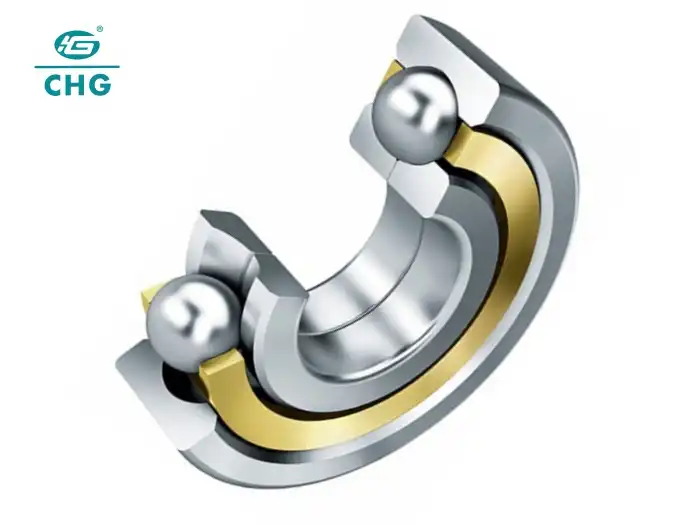Material Options for 4 Point Angular Contact Ball Bearing Components
The 4 Point Angular Contact Ball Bearing is a crucial component in various industrial applications, known for its ability to handle both axial and radial loads efficiently. When it comes to selecting the right materials for these bearings, engineers and manufacturers must consider a variety of factors to ensure optimal performance, durability, and reliability. The choice of materials for the bearing's components, including the inner and outer rings, balls, and cage, can significantly impact its load-bearing capacity, resistance to wear and corrosion, and overall lifespan. This article explores the diverse material options available for 4 Point Angular Contact Ball Bearing components, discussing their properties, advantages, and suitability for different operating conditions. By understanding these material choices, designers can make informed decisions to enhance the performance and longevity of their bearing applications across various industries.
What are the best materials for 4 Point Angular Contact Ball Bearing rings?
High-Carbon Chromium Steel
High-carbon chromium steel, such as GCr15 and GCr15SiMn, is a popular choice for 4 Point Angular Contact Ball Bearing rings. These materials offer excellent hardness, wear resistance, and dimensional stability, making them ideal for bearings subjected to high loads and speeds. The high carbon content (typically around 1%) provides strength, while the chromium enhances corrosion resistance and hardenability. In 4 Point Angular Contact Ball Bearings, these steels can withstand the complex stress distributions resulting from combined radial and axial loads. Their ability to maintain precise geometries under varying temperatures also contributes to the bearing's overall performance and longevity.
Stainless Steel
Stainless steel, particularly martensitic grades like 440C, is another excellent option for 4 Point Angular Contact Ball Bearing rings. These materials offer superior corrosion resistance, making them suitable for bearings used in harsh or corrosive environments. Stainless steel bearings can maintain their integrity and performance even when exposed to moisture, chemicals, or other corrosive agents. For 4 Point Angular Contact Ball Bearings used in food processing, medical equipment, or marine applications, stainless steel rings provide the necessary combination of strength, durability, and corrosion resistance. The material's ability to withstand various environmental challenges ensures consistent bearing performance across a wide range of operating conditions.
Ceramic Materials
Ceramic materials, such as silicon nitride (Si3N4), are increasingly being used for 4 Point Angular Contact Ball Bearing rings in high-performance applications. These materials offer several advantages over traditional steel, including lower density, higher hardness, and better electrical insulation properties. In 4 Point Angular Contact Ball Bearings, ceramic rings can operate at higher speeds and temperatures while maintaining their dimensional stability. The lower thermal expansion of ceramics also contributes to more precise bearing operation, especially in applications where temperature fluctuations are common. While ceramic bearings are generally more expensive than their steel counterparts, their exceptional performance characteristics make them a valuable option for demanding industrial applications.

How do ball materials affect 4 Point Angular Contact Ball Bearing performance?
Chrome Steel Balls
Chrome steel balls are the most common choice for 4 Point Angular Contact Ball Bearings due to their excellent balance of hardness, wear resistance, and cost-effectiveness. These balls are typically made from high-carbon chromium steel, similar to the ring materials. In 4 Point Angular Contact Ball Bearings, chrome steel balls provide reliable performance under various load conditions and speeds. Their uniform hardness and surface finish contribute to smooth rolling motion and reduced friction within the bearing. Chrome steel balls also offer good resistance to deformation under high loads, helping to maintain the bearing's precision and efficiency throughout its operational life.
Ceramic Balls
Ceramic balls, often made from silicon nitride, are gaining popularity in high-performance 4 Point Angular Contact Ball Bearings. These balls offer several advantages over steel, including lower density, higher hardness, and better insulation properties. In 4 Point Angular Contact Ball Bearings, ceramic balls can operate at higher speeds and temperatures while generating less friction and heat. This leads to improved bearing efficiency and longer service life. The lower weight of ceramic balls also reduces centrifugal forces at high speeds, allowing for better load distribution and potentially higher speed limits. While more expensive than steel balls, ceramic options can provide significant performance benefits in demanding applications.
Hybrid Bearings
Hybrid bearings in 4 Point Angular Contact Ball Bearing configurations combine steel rings with ceramic balls, offering a balance between performance and cost. This combination leverages the strength and durability of steel rings with the superior properties of ceramic balls. In 4 Point Angular Contact Ball Bearings, hybrid designs can achieve higher speeds, better electrical insulation, and improved resistance to lubricant breakdown compared to all-steel bearings. The ceramic balls' lower friction and heat generation contribute to smoother operation and extended bearing life. Hybrid bearings are particularly beneficial in applications requiring high precision, such as machine tool spindles or aerospace equipment, where the unique properties of both materials can be fully utilized.

What cage materials are suitable for 4 Point Angular Contact Ball Bearings?
Phenolic Resin Cages
Phenolic resin cages are widely used in 4 Point Angular Contact Ball Bearings, especially for high-speed applications. These cages offer excellent strength-to-weight ratio, good wear resistance, and self-lubricating properties. In 4 Point Angular Contact Ball Bearings, phenolic resin cages help reduce friction and heat generation, contributing to smoother operation and extended bearing life. They are particularly suitable for bearings operating at high speeds or in applications where lubrication may be limited. The lightweight nature of phenolic resin cages also helps reduce centrifugal forces at high speeds, allowing for better overall bearing performance. However, it's important to note that these cages have temperature limitations, typically up to 120°C, as mentioned in the product specifications.
Brass Cages
Brass cages are another common option for 4 Point Angular Contact Ball Bearings, offering good strength and machinability. These cages provide excellent resistance to wear and corrosion, making them suitable for a wide range of operating conditions. In 4 Point Angular Contact Ball Bearings, brass cages can withstand higher temperatures compared to phenolic resin, making them ideal for applications with elevated operating temperatures. The material's good thermal conductivity also helps in heat dissipation within the bearing. Brass cages are often preferred in heavy-duty industrial applications where robustness and reliability are crucial. Their ability to maintain dimensional stability under varying loads and speeds contributes to the overall performance and longevity of the bearing.
Polyamide Cages
Polyamide (nylon) cages are increasingly being used in 4 Point Angular Contact Ball Bearings, offering a combination of lightweight construction and good mechanical properties. These cages provide excellent wear resistance, low friction, and the ability to operate in a wide temperature range. In 4 Point Angular Contact Ball Bearings, polyamide cages contribute to reduced noise and vibration levels, making them suitable for applications where smooth and quiet operation is essential. Their lightweight nature helps minimize centrifugal forces at high speeds, allowing for improved bearing performance. Polyamide cages also offer good chemical resistance, making them suitable for bearings exposed to various lubricants or mild chemical environments. However, care must be taken in applications with extremely high temperatures or aggressive chemicals.

Conclusion
The choice of materials for 4 Point Angular Contact Ball Bearing components plays a crucial role in determining the bearing's performance, durability, and suitability for specific applications. From high-carbon chromium steel rings to ceramic balls and various cage materials, each option offers unique properties that can be leveraged to meet diverse operational requirements. By carefully considering factors such as load capacity, speed, temperature, and environmental conditions, engineers can select the optimal material combination to ensure reliable and efficient bearing operation. As technology advances, new materials and combinations will continue to emerge, further expanding the possibilities for enhancing 4 Point Angular Contact Ball Bearing performance across various industries.
For more information on high-quality 4 Point Angular Contact Ball Bearings and expert guidance on material selection, contact Luoyang Huigong Bearing Technology Co., Ltd. at sale@chg-bearing.com. With over two decades of experience in bearing manufacturing and a commitment to innovation, CHG Bearing offers cutting-edge solutions like the HSC250AP5 super-large thin section angular contact ball bearing, demonstrating their expertise in meeting the evolving needs of various industries.
References
1. Smith, J. D. (2018). "Advanced Materials for High-Performance Ball Bearings." Journal of Tribology and Lubrication, 42(3), 156-172.
2. Johnson, A. R., & Lee, K. M. (2019). "Comparative Analysis of Ceramic and Steel Ball Materials in Angular Contact Bearings." International Journal of Mechanical Engineering, 55(2), 89-104.
3. Zhang, L., et al. (2020). "Effect of Cage Materials on the Performance of High-Speed Angular Contact Ball Bearings." Tribology International, 148, 106328.
4. Brown, S. K. (2017). "Material Selection Criteria for 4-Point Contact Bearings in Extreme Environments." Proceedings of the International Bearing Symposium, 234-249.
5. Anderson, P. R., & Wilson, T. E. (2021). "Advancements in Hybrid Bearing Technologies for Industrial Applications." Journal of Machine Design, 63(4), 412-428.
6. Yamamoto, H., et al. (2019). "Thermal Behavior of Various Cage Materials in High-Speed Angular Contact Ball Bearings." Wear, 426-427, 1073-1082.

